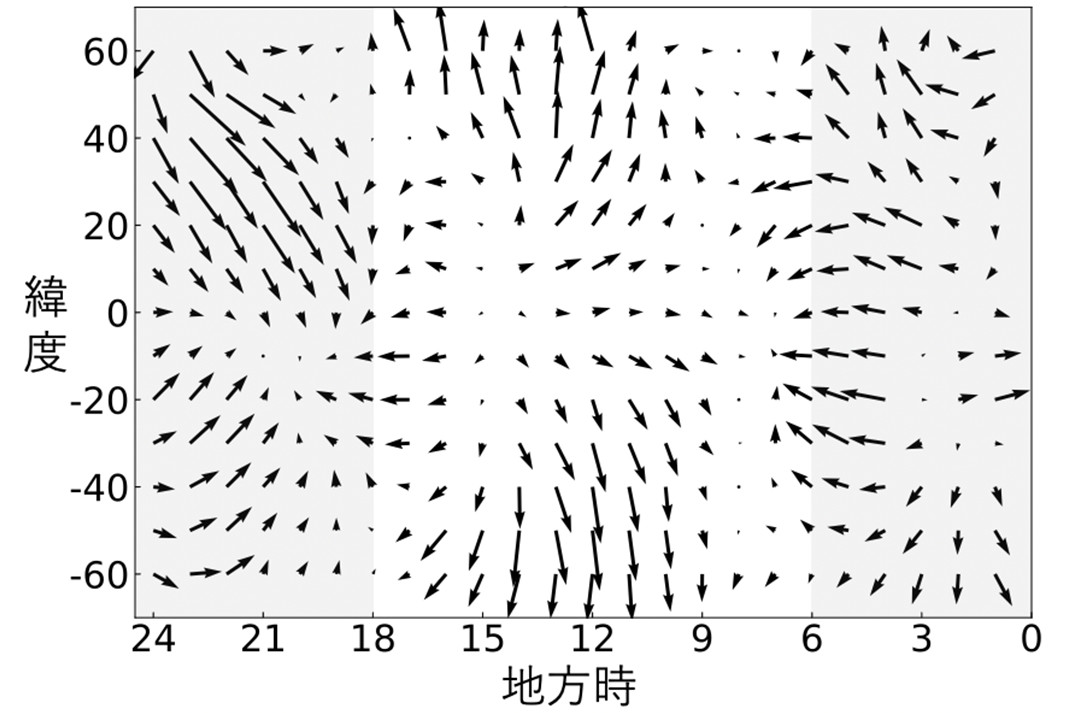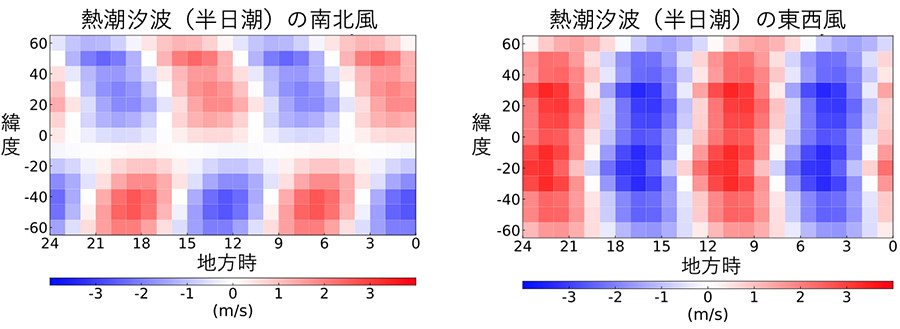OBJECTIVE.
Key points:
- The first-ever around-the-clock measurement of the distribution of wind speeds on Venus (Note 1) at cloud height has been conducted, resulting in an understanding of the mechanism for high-speed atmospheric circulation and the average north-south circulation (Fig. 1).
- It has been a mystery for 40 years what flow pattern occurs on the cloud top of Venus in the nighttime. Our group has discovered that north-south winds occur in the nighttime moving in the opposite direction to those in the daytime (Fig. 2).
- Venus is enveloped by thick clouds and rotates slowly. The environment is very different from that on Earth. The obtained understanding of the atmospheric circulation on Venus will therefore serve to clarify the creation of and mechanism for diverse environments on terrestrial planets.
Summary:

Fig. 1: Distribution of wind speeds on Venus for latitude and local time, with the influence of super-rotation subtracted. The shaded areas indicate nightside, on which the distribution has been obtained for the first time by this study. Arrow length is proportional to wind speed and scaled such that the length occupied by 10° in latitude represents 5m/s. (edited from Fukuya et al., 2021)

Fig. 2: An image of the newly revealed circulation near the cloud layer of Venus. Poleward flow (light blue, on right) dominates on the dayside and the equatorward flow (yellow, on left) dominates on the nightside while overlapping with the super-rotation (red) over the entire planet. The equatorward nightside flow discovered through infrared observation in this study offsets the poleward dayside flow. The difference between the dayside and nightside flows is caused by thermal tides. The dayside image was captured by an ultraviolet imager (UVI) and the nightside image was captured by an infrared camera (LIR), both onboard the Venus orbiter Akatsuki. (Venus image provided by JAXA)
Notes:
- (Note 1) Venus
Venus is a planet with a rocky surface (terrestrial planet) and is Earth’s immediate neighbor on the side of the sun. Its size and density are close to those of Earth. From Earth, Venus is the brightest celestial body, except for the sun and moon, and is therefore also called a “morning star” or “evening star.” It has a dense atmosphere rich in carbon dioxide, causing the greenhouse effect and the subsequent surface temperature rise to reach about 460°C. Clouds of sulfuric acid are present at heights of 50-70km from the surface. It rotates very slowly, with a rotation period as long as 243 days. In contrast, the atmosphere circles around Venus in just four days due to the high-speed wind from the east, which is called super-rotation (Note 2).
- (Note 2) super-rotation
Super-rotation (atmospheric super-rotation) is a phenomenon in which a planet’s atmosphere circulates faster than the planet’s rotation over a wide latitudinal range that includes the equatorial region. On Venus, winds caused by the phenomenon are observed in every latitude band. Wind blows faster in higher altitudes from its surface, reaching a maximum of 100m/s near the cloud-top region at an altitude of about 65km. These winds are very different from winds on Earth, and the mechanism for the phenomenon is not well known. Similar winds are observed on Titan, a moon of Saturn. Observations have been reported to indicate that super-rotation is also present on exoplanets.
- (Note 3) Hadley circulation
Since the equator and neighborhood of a planet receive much solar energy, the atmosphere is warmer near the equatorial region and cooler at higher latitudes. To eliminate the temperature difference, the warm atmosphere of the equatorial region rises, flows into the upper atmosphere and moves toward higher latitudes, where it then descends into the lower atmosphere and comes back to the equatorial region. The system is called Hadley circulation. On Earth, it occurs between the equatorial region and around the latitude of about 30°. On Venus, it is assumed to occur near the cloud top and near the planet surface, which are better heated by sunlight, possibly occurring from the equatorial region to high latitudes unlike on Earth. Hadley circulation overlaps and coincides with an east-west wind (super-rotation on Venus) but its circulation speed is much slower in general.
- (Note 4) Thermal tide
When planetary atmospheres are heated by sunlight at and near points where the sun is directly overhead, and the points move relative to the atmosphere due to the planet’s rotation and the atmosphere’s circulation, fluid waves occur on a planetary scale. Such waves are called thermal tides and are observed widely, such as on Earth and Mars as well as Venus. Thermal tides propagate not only in the east-west direction but also in the vertical direction, transferring momentum between different heights to cause the averaged east-west wind to accelerate/decelerate. Unlike ocean tides, thermal tides are not affected by the attraction of the moon and other celestial bodies.
- (Note 5) Akatsuki
Akatsuki is a Venus orbiter of the Japan Aerospace Exploration Agency (JAXA). Akatsuki was launched in May 2010 and finally entered a Venus orbit in December 2015 after orbiting the sun for five years, including the delay period caused by a propulsion system problem that occurred on its voyage to Venus. The orbiter, as a meteorological satellite of Venus, continues imaging and observing the atmosphere using five cameras that take images at different wavelengths from the orbit. Akatsuki also conducts observations of Venus’ atmosphere using communication radio waves from an antenna on the Earth.
Project website: Venus Climate Orbiter AKATSUKI (jaxa.jp)
The movement of Venus’ atmosphere has previously been estimated mainly from a series of images of the clouds illuminated by solar ultraviolet light in the daytime. The use of ultraviolet light enables shaded patterns of chemical substances in the clouds to be seen, allowing the clouds to be tracked.
This tracking has revealed that in addition to super-rotation, the movement of Venus’ atmosphere includes a flow of about 10m/s from the equator toward both poles. When the poleward flow was discovered about 40 years ago, it was understood to have been caused by the Hadley circulation, which is a mean circulation in which atmosphere heated by sunlight in the equator region rises and flows toward high latitudes. However, in recent years, it has been pointed out that the poleward flow is a part of thermal tides, which are fluid waves caused by atmospheric heating by sunlight. Their respective contributions have not been well understood.
The Hadley circulation causes a mean flow of all north-south winds both in the daytime and nighttime around the clock, while the thermal tides cause the difference in the daytime and nighttime winds. The Hadley circulation and thermal tides are the two main atmospheric phenomena both caused when the clouds covering the whole of Venus receive sunlight. The Hadley circulation is responsible for the circulation of energy and matter, while the thermal tides may be involved in the maintenance of super-rotation. Clarifying the two phenomena is indispensable to understanding Venus’ atmosphere. To clarify their entire system, there has been a need to observe the planet day and night continuously.
To monitor the nighttime movement of clouds, there is a method of imaging infrared light emitted by the clouds to track differences in the temperatures of the cloud top at different points. However, Venus as a whole has never been imaged with infrared light on a continuous basis in the past, and no clear patterns have been obtained from infrared images. Our group acquired cloud images approximately every hour over a period of two years with an infrared camera (thermography) LIR onboard the Venus orbiter Akatsuki.
Since making distinctions between temperature variations and noise is difficult, we reduced noise by shifting multiple images relative to each other and superimposing one on another for averaging, taking into account the movement of clouds caused by super-rotation (Fig. 3). With this process, minute temperature fluctuations in the cloud top of about ±0.3°C became visible, successfully visualizing the movement of the atmosphere (videos 1 and 2).

Fig. 3: (Left) An infrared image of Venus taken by LIR. (Center) An infrared image mapped to the geographic coordinates of Venus to highlight fine patterns. (Right) Same as the center image with noise reduced by an image-averaging process. (edited from Fukuya et al., 2021)
Video 1: Nightside cloud movement seen in infrared light. The cloud pattern converges from high latitudes toward the equator.
Video 2: Dayside cloud movement seen in infrared light. The cloud pattern spreads from the equatorial region toward high latitudes.

Fig. 4: (Left) Horizontal structure of north-south winds by the thermal tide, with northward direction as positive and southward direction as negative. (Right) Horizontal structure of east-west winds by the thermal tide, with eastward direction as positive and westward direction as negative. (edited from Fukuya et al., 2021)
The analysis results have suggested that the thermal tides contain strong semidiurnal tide components, which have two wavelengths while circling around Venus in the east-west direction and transmit force in the altitude direction (transporting the east-west momentum in the altitude direction), contributing to maintaining the super-rotation (Fig. 4).
Our study has revealed the mechanism for Hadley circulation and thermal tides. From now on, studies on Venus’ atmospheric physics using numerical simulations will aim to reproduce their results. Obtaining the ability to observe the distribution of winds and temperatures on the cloud top on Venus dayside and nightside has opened the possibility of tracking time-based changes in various atmospheric phenomena, bringing a new approach to Venus’ meteorology.
It is assumed that the response of atmospheric dynamics to the solar heating of the cloud layer as revealed in our study plays an important role also in the atmospheres of exoplanets, such as generating super-rotation. It is expected that further understanding will be achieved through collaborations between solar system meteorology and exoplanet science.
International publication:
- Journal:Nature
- Paper title:The nightside cloud-top circulation of the atmosphere of Venus
- Authors:Kiichi Fukuya*, Takeshi Imamura*, Makoto Taguchi, Tetsuya Fukuhara, Toru Kouyama, Takeshi Horinouchi, Javier Peralta, Masahiko Futaguchi, Takeru Yamada, Takao M. Sato, Atsushi Yamazaki, Shin-ya Murakami, Takehiko Satoh, Masahiro Takagi, Masato Nakamura
- DOI:10.1038/s41586-021-03636-7
- Abstract URL:https://www.nature.com/articles/s41586-021-03636-7
